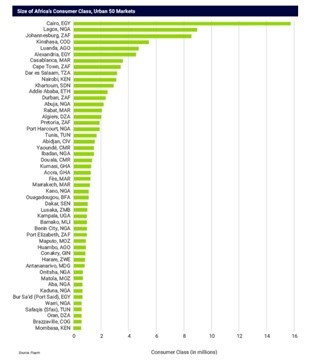The African consumer class is one of the largest remaining prizes for consumer-facing companies and investors in the world, according to geospatial data company Fraym. While country-level insights can be useful for prioritising market entry and expansion, the company asserts that understanding precise geographic concentrations of target consumers is essential for an effective go-to-market strategy.
Driven by this belief, a new report by Fraym, Finding the Dynamic African Consumer Class, uses geospatial data to identify, locate and reach 330 million valuable African consumers – with precision down to 1x1 square kilometers. The signature study is said to provide insights that will help all companies, including major multinationals, accelerate their growth in Africa.
According to Fraym, the most accurate go-to-market approaches require identifying the characteristics of consumers in specific urban clusters. New technology can locate different consumer segments in almost any urban area across the African continent – looking at the actual city 'footprint', including suburbs and informal settlements.
"Powerful new technology makes it possible to identify, locate, and reach valuable consumers across Africa. Consumer-facing companies typically target those who can purchase ‘premium products’ - here, we call segments of this group the Consumer Class, or ABC1 consumers," says the company.
Top five markets in Africa
Ninety-five percent of the African consumer class is located in just 20 countries, according to the study. For their sheer scale, five consumer markets stand out above the others. Egypt is the largest African market with 78 million people in the consumer class. It also accounts for nearly one-quarter of all consumers across the continent.
Nigeria accounts for the second largest consumer class, with 52 million people. South Africa, Morocco, and Algeria round out the top five. In total, these 'power five' markets have a combined consumer class of 219 million people, or roughly two-thirds of the continent’s total.
Key urban markets in Africa

Top 50 urban markets in Africa. Source: Fraym
click to enlargeAmong the continent’s major cities, Cairo is home to the largest consumer class by far, comprising 16 million people. Cairo also has the greatest number of premium “A category” consumers, or those with the most spending power, at 3.5 million.
Nigeria’s fast-growing commercial capital of Lagos is next with 9 million ABC1 consumers – or those who can afford premium products. Johannesburg, despite its outsized global profile and role in African business, comes in third with 8.5 million ABC1 consumers.
Fraym says that Kinshasa, the capital of the DRC, is a vast city in a country with very little traditional market data. New data and methods, however, have found 5.5 million ABC1 consumers, putting the city firmly in fourth place among urban consumer markets on the continent.
Moving down the list, there are several other cities that may be surprising as well, such as Luanda, Khartoum, and Yaoundé. The Fraym data also reveals a number of sizeable consumer class populations in non-capital cities, such as Alexandria (Egypt), Durban (South Africa), Port Harcourt (Nigeria), Ibadan (Nigeria), and Douala (Cameroon).
The top fifty urban markets in Africa account for 80% of the continent’s urban consumer class, with 10 of these largest African markets located in Nigeria. Outside of South Africa, the top five urban markets of Southern Africa are Luanda, Lusaka, Maputo, Huambo and Harare, and together they account for 8.4 million consumers (roughly equivalent to Johannesburg’s consumer potential).
To read the full report, visit fraym.io/consumerreport.



























